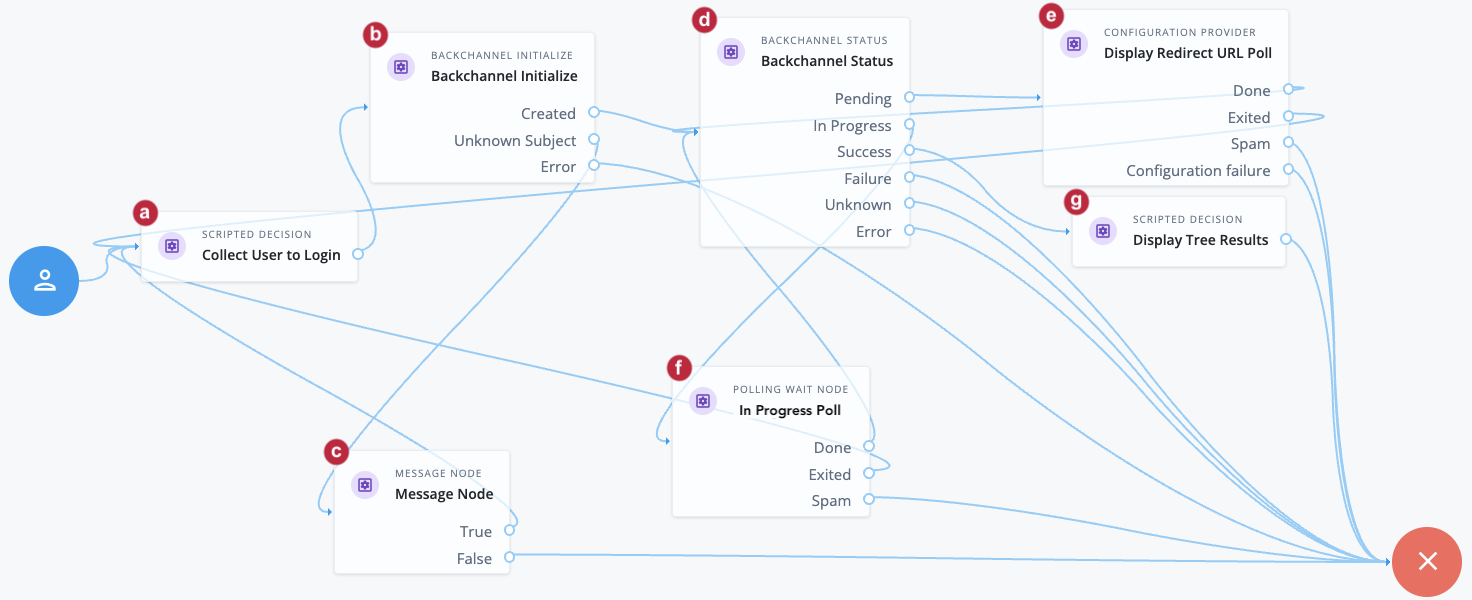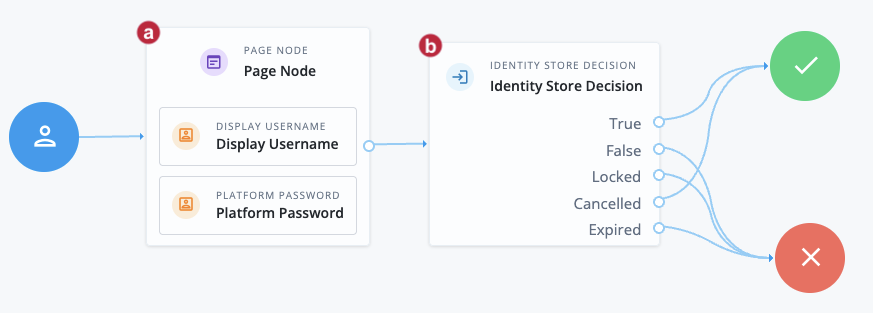Backchannel Initialize node
The Backchannel Initialize node lets you start a separate journey that runs asynchronously, possibly by a different user or agent. The node takes an incoming user ID and generates a URL to a journey where the identified user or agent authenticates.
Together with the Backchannel Status node, this node lets you implement backchannel authentication from within a journey. Find more information in Backchannel authentication.
Example
This example uses the Backchannel Initialize and Backchannel Status nodes to implement backchannel authentication.
The example shows two journeys:
-
The main journey initializes a backchannel authentication journey.
-
The backchannel journey is a simple authentication journey.
Main journey

a The Collect User to Login node is a Scripted Decision node. The script writes the attributes required for the backchannel authentication into the shared state.
Sample Scripted Decision node script
The script queries the backend identity object to get the userId, then writes that and the attributes required for the backchannel authentication into the shared state.
if (callbacks.isEmpty()) {
// Request callbacks
callbacksBuilder.nameCallback("User to authenticate");
} else {
// Callbacks returned from browser, save username and password
var username = callbacks.getNameCallbacks().get(0);
var queryRes = openidm.query("managed/alpha_user", {
"_queryFilter": `/userName eq '${username}'`
}, ["*", "_id"]);
var userId = queryRes.result[0]._id
var identity = idRepository.getIdentity(userId);
nodeState.putShared("backchannel-user", identity.getName());
nodeState.putShared("backchannel-data", {
"username": username,
"objectAttributes": {
"userName": username,
"_id": userId
}
});
nodeState.putShared("_id", userId);
outcome = "outcome";
}b The Backchannel Initialize node reads the value of the backchannel-user key from the shared state. This key contains the userName:
-
If the
userNameis available and is valid, the node generates a redirect URI to start the backchannel authentication journey. The node writes the redirect URI and the transaction ID of the backchannel transaction to the shared state, and the journey proceeds to the Backchannel Status node. -
If the
userNamecan’t be read, the journey follows the Error outcome and fails. -
If the
userNamecan be read but the user or agent isn’t valid, the journey proceeds to a Message node (c) and redirects the user to the start of the journey to attempt gathering data again.
d The Backchannel Status node reads the transaction ID and provides status on the authentication request:
-
If the backchannel authentication request is
Pending, the journey proceeds to the Display Redirect URL Poll node (e), which is a Configuration Provider node. -
When the backchannel authentication is
In progress, the journey proceeds to the In Progress Poll node (f), which is a Polling Wait node. -
When the backchannel authentication completes successfully, the journey proceeds to the Display Tree Results node (g), which is a Scripted Decision node.
e
The Configuration Provider node imitates a Polling Wait node that uses a script to display the backchannel redirect URI as long as the backchannel authentication request is in a Pending state.
Sample Config Provider node script
var uri = nodeState.get("backchannel-redirectUri").asString();
config = {
"spamDetectionTolerance": 3,
"spamDetectionEnabled": true,
"exitMessage": {},
"waitingMessage": {
"en": uri
},
"secondsToWait": 5,
"exitable": true
};-
After 5 seconds, the journey returns to the Backchannel Status node.
-
If the journey exits before it returns to the Backchannel Status node, the user is redirected to the start of the main journey to attempt gathering data again.
-
If the Configuration Provider node detects spam or misconfiguration, the main journey follows the failure outcome path.
f The In Progress Poll node is a Polling Wait node that pauses the main journey until the Backchannel journey is complete.
-
After 8 seconds, the journey returns to the Backchannel Status node.
-
If the journey exits before it returns to the Backchannel Status node, the user is redirected to the start of the main journey to attempt gathering data again.
-
If the node detects spam, the main journey follows the failure outcome path.
g The Display Tree Results node is a Scripted Decision node that displays the outcome of the backchannel authentication journey.
Sample Scripted Decision node script
/*
- Data made available by nodes that have already executed are available in the sharedState variable.
- The script should set outcome to either "true" or "false".
*/
if (callbacks.isEmpty()) {
var sessionProperties = nodeState.get("backchannel-sessionProperties");
callbacksBuilder.textOutputCallback(0, sessionProperties);
} else {
outcome = "outcome";
}| This journey always ends on the Failure node as it is not in itself an authentication journey. |
Backchannel authentication journey

This is a basic authentication journey that takes credentials and authenticates the user based on their existence in the backend identity store.
a The Page node includes a Display Username node and a Platform Password node. The username has been supplied in the shared state from the main journey. The user needs to enter their password.
b The Identity Store Decision node assesses the user credentials. Find more information on this node and its outcomes in Identity Store Decision node.
The main journey polls for completion of this subjourney. When this journey completes, the main journey continues.
Availability
| Product | Available? |
|---|---|
PingOne Advanced Identity Cloud |
Yes |
PingAM (self-managed) |
Coming soon in PingAM 8.1 |
Ping Identity Platform (self-managed) |
Coming soon in Ping Identity Platform 8.1 |
Inputs
This node optionally reads the user ID of the subject the journey’s being initialized for from the incoming node state. The user ID is stored in the nodeState key specified in the Subject Name Key property.
Configuration
| Property | Usage | ||
|---|---|---|---|
Journey |
The asynchronous journey to initialize. Select a journey from the list of configured journeys. |
||
Subject Type |
The type of subject to initialize the journey for:
|
||
Subject Name Key |
The This property is ignored if the Subject Type is |
||
Data Object Key |
The node state key that contains the data object (if present) to pass to the journey at the root level of the shared state. |
||
Redirect URL Type |
The type of redirect URL to save to node state: By default, the base URL of the redirect URI is retrieved from the incoming HTTP request.
|
||
Custom Redirect URL |
If Redirect URL Type is |
||
Max Time (Seconds) |
The maximum number of seconds to wait for the backchannel journey to complete before timing out. This lets you set a specific timeout for each backchannel journey, depending on the expected completion time for the journey.
If you don’t set a value here, the backchannel journey times out after the Time to Live set for the realm. You can change this under Native Consoles > Access Management > Realms> Realm Name > Services > Transaction Authentication Service > Time to Live. |
Outputs
The node writes the following to the shared state:
| Shared state key | Information |
|---|---|
|
The transaction ID of the backchannel authentication request. |
|
The generated redirect URI. |
|
An optional data object with additional information about the authenticating user. |
Outcomes
Created-
The journey follows this outcome path if the node was able to create the backchannel authentication request.
Unknown Subject-
The journey follows this outcome path if the subject in the incoming node state doesn’t match an identity object in the backend identity store.
Error-
The journey follows this outcome path if the node can’t retrieve the subject from the node state.